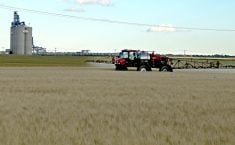The company’s new engine, which doesn’t require DEF fluid, has now been made standard in its full 9000 series lineup
John Deere’s new JD18X 18-litre engine is now standard in the 9000 series forage harvester lineup and doesn’t require DEF fluid.
Last year Deere had a limited release of its 9500 forage harvester that comes with that engine, and also upgraded the 9600 forage harvester with it.
This year the company updated the 9700 model forage harvester with the new engine to complete the transition for the entire 9000 series.
The 9500 forage harvester is the smallest in the company’s 9000 wide-body series. With the new engine, it is rated at 755 horsepower, while the 9600 has 775 h.p. and the 9700 has 813.
Read Also

House ag committee to undertake several studies
The House of Commons standing agriculture committee has set its agenda for the coming months. Members began the fall sitting with a two-hour update on international trade
The 9900 is Deere’s largest self-propelled forage harvester with a 956 h.p. and a 24-litre Liebherr V12 engine. The smallest Deere forage harvester in the 8000 series is the 8100, with a FT4 Deere engine and 380 h.p.
“There’s no DEF or after treatment system on these. We built this engine from the ground up with that in mind. It’s able to meet all environmental standards that are set, as well as not require that fluid,” said Chase Milem, market specialist for hay and forage equipment with John Deere.
“Essentially the customers should see up to a 13 percent fluid efficiency gain on these machines, which directly impacts their bottom line.”
Milem said the JD18X engine has HarvestMotion Plus technology, which has a torque-rise that produces extra power at low engine RPM, so operators can push through tough conditions while maintaining quality.
The JD18X features a 750-hour service interval, 33 percent longer than the 13.5L engine on the previous forage harvesters in this class.
Milem said the 9500 was developed to fit a market segment not previously addressed.
“Ten years ago, what the customer wanted was around that 500 to 600 horsepower machine. We’ve seen a big shift to 700 plus horsepower. So, you know, we stepped back, and we looked at our lineup and where that horsepower range landed.
“We noticed an opportunity in that 700 to 800 horsepower range. So that’s what we’ve done with our introduction to our 9500.”
Both the 9,000 and 8,000 series forage harvesters are built in Zweibrücken, Germany, while the 18.0L engine is manufactured at the John Deere Engine Works plant in Waterloo, Iowa.
The 9500 forage harvester comes with a spout design for less plugging in tough conditions.
Milem said the geometry of the spout has been changed and additional cleanouts added.
“What we’ve noticed is a customer that maybe was running in some sticky alfalfa, it gets to a certain moisture level where you just can’t run anymore because it plugs the machine,” he said.
“We’ve seen a minimum of an hour increase in running time, just due to the change in the spout geometry of it, and it allows for better visibility for that operator as well.”
John Deere Premium or XStream KP kernel processors in the 9000 series forage harvesters are used to maintain forage quality and kernel processing by delivering high corn silage processing scores regardless of cut length, Milem said.
Options for the 9000 series forage harvesters include AutoTrac RowSense guidance and John Deere’s HarvestLab 3000, which can be used as a sensing tool and as a stand-alone stationary test unit that can analyze up to seven components of feed.
“These constituents include NDF, crude protein, moisture, sugar, starch, crude fibre, ash and ADF,” Milem said.


















